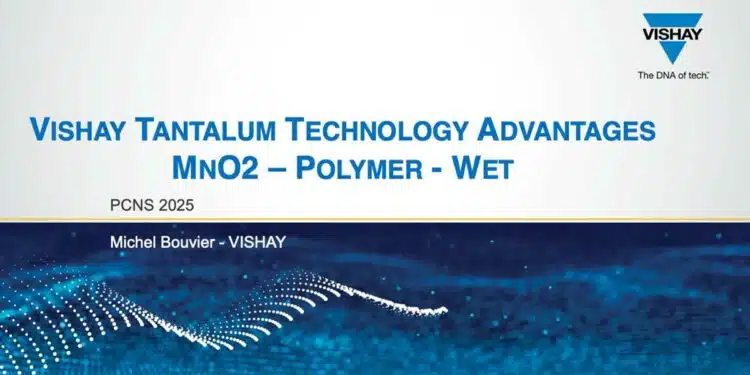The paper “Tantalum Capacitor Technology Advantages for Harsh Environment” was presented by Michel Bouvier, Vishay Europe, Le Pecq, France at the 5th PCNS Passive Components Networking Symposium 9-12th September 2025, Seville, Spain as paper No. 1.2.
Introduction
Vishay has continuously developed advanced tantalum capacitor technologies to address the challenges of harsh environments such as aerospace, military, space, underwater, and critical industrial applications. Environments with extreme temperatures, high mechanical stresses, and severe electrical conditions demand components with exceptional reliability.
Traditional commercial capacitors often fail under such conditions, prompting the need for enhanced material selection, refined manufacturing processes, and protective packaging solutions.
Vishay’s innovations—from advanced anode technologies to MAP packaging and hermetic designs—provide robust performance, long-term reliability, and low DC leakage.
Key Points
- Advanced Tantalum anode technology using liquid delubrication, magnesium deoxidation, beveled pellet pressing, and welded wire attachment.
- Defect-free Ta₂O₅ dielectric formation resulting in low DC leakage and improved reflow resistance.
- MAP (Multiple Array Packaging) technology delivers ~40% increased capacitive volume with stable MSL performance.
- HiRel screening and statistical DCL methods ensure high reliability under life testing.
- Hermetically sealed polymer and wet tantalum capacitors provide enhanced stability in extreme conditions.
- Specialized solutions for high temperature, mechanical stress, and mission-specific harsh environment applications.
Extended Summary
Vishay’s approach to harsh-environment capacitors begins with technological enhancements at the anode level. The company introduced top-down pressed beveled pellets, which solve the common issue of corner weaknesses in polymer-coated capacitors. This geometry ensures uniform cathode coverage, reducing short failures. Liquid delubrication replaces traditional high-temperature burn-out methods, reducing carbon residuals from ~300 ppm to ≤30 ppm, enabling the formation of defect-free Ta₂O₅ dielectric films. Magnesium deoxidation further enhances the dielectric’s integrity by lowering oxygen content, optimizing reliability and performance under stress.
Welded anode wire attachment strengthens mechanical connections, mitigating failures during thermal reflow. Vishay has also implemented Shell Formation, a process that creates a thicker dielectric layer on the anode’s outer surface to endure thermo-mechanical and electrical stress during soldering and testing.
Packaging innovations play a central role. The MAP (Multiple Array Packaging) technology allows for approximately 40% higher volumetric efficiency than traditional molded packaging, without sacrificing Moisture Sensitivity Level ratings. This brings advantages in module assembly, weight reduction, and improved high-frequency performance. Hermetic solutions, such as the T27 vPolyTan™ series, provide additional protection against conductive polymer degradation from thermo-oxidation, ensuring long-term parametric stability.
Reliability is reinforced through Vishay’s comprehensive testing and screening regime. Processes include reflow conditioning, surge current testing, accelerated voltage conditioning, thermal shock, and patented statistical DC Leakage (DCL) screening at elevated temperature and voltage. Life test results demonstrate that Vishay polymer capacitors maintain stable DCL values over 10,000 hours, while competitors often show increased leakage and early failures.
The company also addresses extreme temperature requirements. Tantalum MnO₂ capacitors can operate up to 200°C, making them suitable for oil drilling and aerospace applications. Polymer capacitors are typically rated for up to 125°C, with some limited solutions for 150°C, supporting automotive AEC-Q200 environments. Wet tantalum capacitors remain the choice for very high-temperature, high-voltage designs beyond 150°C.
Mechanical stress resilience is critical for applications like space launchers and oil drilling. Vishay products undergo rigorous vibration and shock testing, with hermetic and vibration-proven enclosures like T27 and T22/T24 ensuring electrical parameter stability even under 53G random vibration or 1000G shocks.
For failure-rate assessments, polymer tantalum capacitors exhibit such low intrinsic failure mechanisms that traditional 100% FR grading is not practical. Instead, lot-based accelerated testing is used under MIL-PRF-32700 guidelines, with Arrhenius and Prokopowicz-Vaskas models applied to calculate acceleration factors for temperature and voltage stress.
Conclusion
Vishay’s advanced Tantalum capacitor technology offers a complete solution for demanding, harsh-environment applications. By combining defect-free anode fabrication, innovative packaging such as MAP, hermetic sealing, and rigorous testing protocols, the company delivers components with exceptional stability, low DC leakage, and long service life. These innovations not only exceed industry reliability standards but also reduce system-level risk in critical missions. Future progress will focus on extending temperature ranges, improving lifetime performance, and working closely with system designers to achieve optimal solutions for the most challenging environments.






























